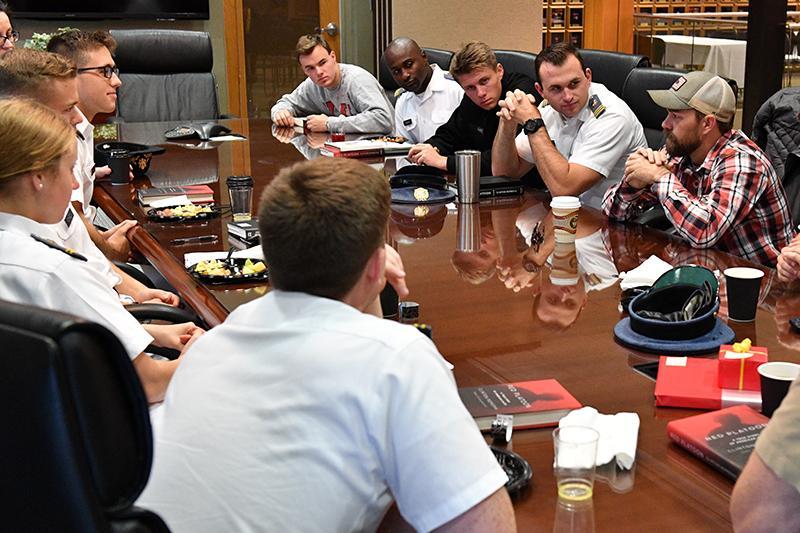2018-2019 | VMI Ranked Highly by Major Media Outlets
GRIT: Growth, Resilience, Integrity, and Tenacity

Clint Romesha meets with members of the Cadet Book Club to discuss his book Red Platoon.—VMI Photo by H. Lockwood McLaughlin.
LEXINGTON, Va., October 30, 2018—GRIT, as defined by VMI’s Center for Leadership and Ethics, is exemplified by the virtues of growth, resilience, integrity, and tenacity. These attributes are embodied by the many speakers featured during the CLE’s annual Leadership Conference in Marshall Hall.
The conference drew students and faculty from institutions across the state and the nation, including Texas A&M University, Hampton University, and the U.S. Air Force Academy.
Bill Bennett, the conference’s keynote speaker, opened the conference by reflecting on his time in the federal government under Ronald Reagan and George H.W. Bush. He compared their character with that of our current president.
“The times call for different types of characters and different types of grit. Sometimes in America you need Mother Theresa, sometimes you need Dirty Harry,” Bennett said.
Bennett served as the third U.S. Secretary of Education from 1985-1988 under Reagan. In the following administration, Bennett accepted the position of Director of the Office of National Drug Control Policy, also known as the nation’s first “drug czar,” under former President George H. W. Bush, whom Bennett described as the “kindest, most considerate boss.”
The resilience and growth aspects of GRIT were showcased in a panel with community leaders in Newtown, Connecticut, who witnessed the aftermath of the Sandy Hook Elementary School shooting on Dec. 14, 2012.
The mass shooting killed 20 children and six adults and brought a town of approximately 28,000 people together.
Pat Llodra was the first selectman, similar to a town mayor, of Newtown at the time of the shooting. She said she wanted to convey to the audience how a community can have grit.
“How a community of 27,000, I think it's 28,000 now, was able to, individually and collectively represent in their daily choices that ‘yes, we won’t be defined by this horrible tragedy. We won’t forget it, but tragedy won’t define us,’” she said.
Nancy Crevier, a features reporter at the time of the shooting and now an editor at the Newtown weekly newspaper, The Newtown Bee, said the tragedy showed the ability of every individual to help.
“One of the things is the ability of ordinary people to do extraordinary things when you don’t expect a challenge, which is what we did as a community newspaper,” Crevier said.
All panelists noted a large religious population in the town which was served in part by Monsignor Robert Weiss, a pastor at St. Rose of Lima Roman Catholic Church. Weiss said he remembered putting tags on Christmas presents in the church’s attic when he got the call about the shooting.
“I was brought into an intimate part of this tragedy, meeting with families and planning funerals,” he said.
Almost immediately after, a threat was made against St. Rose church and Weiss recalled the church being under constant SWAT team surveillance while holding funerals for the children.
Llodra noted there are two events after a tragedy happens: the response and the recovery. Neighboring towns stepped up to offer support, even another school for the children to attend because they could not go back to Sandy Hook. Donations flooded in from across the world, including 650,000 stuffed animals for the survivors.
Counseling was another part of the recovery process and Weiss encouraged not only the survivors to pursue help but also the volunteers and workers during that experience.
“Don’t be too proud to get help, you are of no help if you don’t get help yourself,” he said.
Helping yourself before others was another theme in one of the six breakout sessions that followed the panel.
Ryan Glynn ’96 played for VMI’s baseball team while a cadet at VMI and then went on to play for the minor and Major League Baseball as well as on the international field.
Glynn said he struggled during his first few years at VMI with academics.
“[Baseball] was my medicine at VMI, it kept me sane,” he said.
He met internal challenges head-on while traveling back and forth from Calgary, Canada, to Indianapolis to play for two baseball teams. His constant lesson was to take care of himself first.
“You need to build yourself up before anything else,” he said.
Meanwhile, Elise Reed ’15 spoke on the challenges of being a Mixed Martial Arts fighter at her petite size and the grit that kept her going.
“The grit is where there is no instant gratification,” she said. “The tougher challenges are mental.”
At 25 years old, Reed is a combat veteran, owns an MMA school, and has plans for getting into professional MMA fighting.
Other VMI alumni speakers included Will Lyles ’02, a college baseball player, U.S. Army veteran, and double amputee and retired Lt. Gen. Carl Strock ’70, former commanding general of the U.S. Army Corps of Engineers and a VMI Board of Visitors member.
Following dinner Monday evening, participants heard from medal of honor recipient Clint Romesha, who was assigned to the 3rd Squadron, 61st Cavalry Regiment, 4th Brigade Combat Team, 4th Infantry Division. He was presented the Medal of honor in 2013 for actions on Oct. 3, 2009, during a firefight at Combat Outpost Keating in northeastern Afghanistan's Nuristan province.
Romesha, who is the author of Red Platoon, hosted a book signing after his talk and sat down to breakfast with cadets Tuesday morning.
-Ashlie Walter
—VMI—
.svg)
.png)